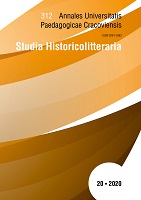Polska epika bohaterska przed i po Gofredzie
Polish heroic poetry before and after Jerusalem delivered
Author(s): Roman KrzywySubject(s): Cultural history, Polish Literature, Sociology of Culture, 16th Century, 17th Century, Theory of Literature, Sociology of Literature
Published by: Wydawnictwo Uniwersytetu Komisji Edukacji Narodowej w Krakowie
Keywords: Old Polish epic poetry; heroic epic; historical epic; Jerusalem delivered; ottava rima;
Summary/Abstract: The article is a review of the most important trends in the development of the Polish epic in the 16th and 17th centuries. In the absence of significant traditions of knightly works, the creation of Polish heroic poetry should be associated primarily with the humanistic move¬ment, whose representatives set a heroic epic at the top of the hierarchy of genres and rec¬ognized Eneid as its primary model. The postulate proposed first by the Renaissance and later by the Baroque authors did not lead to the creation of a ‘real’ epic in Poland. The trans¬lations of: the Virgil’s epic poem (1590) by Andrzej Kochanowski and Book 3 of The Iliad by Jan Kochanowski can be regarded as the genre substitutes. These translations seem to test whether the young Polish poetic language is able to bear the burden of an epic matter. Then again, the works of Maciej Kazimierz Sarbiewski on the Latin Lechias (the 1st half of the 17th century), which was to present the beginnings of the Polish state, were not completed. Polish Renaissance authors preferred themes from modern or even recent history, choosing Bellum civile by Lucan as their general model but they did not refrain from typically heroic means in the presentation of the subject. This is evidenced by such poems as The Prussian War (1516) by Joannis Vislicensis or Radivilias (1592) by Jan Radwan. The Latin epic works were followed by the vernacular epic in the 17th century, when the historical epic poems by Samuel Twardowski and Wacław Potocki were created, as well as in the 18th century (the example of The Khotyn War by Ignacy Krasicki). The publication of Torquato Tasso’s Jerusalem delivered translation by Piotr Kochanowski in 1618 introduced to the Polish liter¬ature a third variant of an epic poem, which is a combination of a heroic poem and romance motives. The translation gained enormous recognition among literary audiences and was quickly included in the canon of imitated works, but not as a model of an epic, but mainly as a source of ideas and poetic phrases (it was used not only by epic poets). The exception here is the anonymous epos entitled The siege of Jasna Góra of Częstochowa, whose author spiced the historical action of the recent event with romance themes, an evident reference to the Tasso’s poem. The Polish translation of Tasso’s masterpiece also contributed to the popularity of the ottava rima, as an epic verse from the second half of the 17th century (previously the Polish alexandrine dominated as the equivalent of the ancient hexameter). This verse was used both in the historical and biblical epic poems, striving to face the rhythmic challenge.
Journal: Annales Universitatis Paedagogicae Cracoviensis. Studia Historicolitteraria
- Issue Year: 2020
- Issue No: 20
- Page Range: 97-122
- Page Count: 26
- Language: Polish

